Some notes on GWR small prairie tanksby Russ Elliott
|
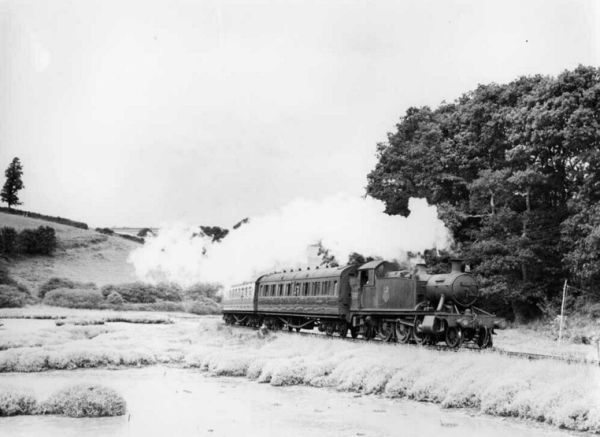 4585 at Terras Bridge, 11 July 1959 4585 at Terras Bridge, 11 July 1959 |
Introduction
Following the success of the prototype large prairie number 99 in 1903, Churchward's first branch line equivalent was a prairie tank with 4'1½" diameter driving wheels and a Standard No 5 boiler. The first loco, 115, was built at Swindon in 1904, with the subsequent ten locos (3101–10) being built at Wolverhampton. They were successful, particularly on steeply-graded lines and branches, but lacked a decent top speed, and Churchward developed the design using 4'7½" driving wheels. This latter development, with production commencing in 1906, became the predominant small prairie type, the 4500 class locos having flat-top 1000g tanks and the later 4575 variant, with the larger sloping-top 1300g capacity tanks, being produced in 1927–9. A total of 175 of the 4500/4575 locos were eventually built.
The smaller-wheeled 115 and 3101–10 were renumbered 4400–10 in 1912. The first 30 of the larger-wheeled locos, initially numbered 2161–2190, became 4500–29. The locos built after 1912 kept their original numbers (4530–99, 5500–74).
Total weights ranged from 55¾T for an early 4400 loco to 61T for a 4575 class loco. 4500/4575 locos were yellow route restiction, whereas the 4400 locos remained uncoloured.
Dimensional variation
For locos that look similar at first sight, there was a surprising amount of dimensional variation between the classes.
The most obvious difference was in the coupled wheelbase, the 4400 being 6'0" + 5'6" whilst the 4500/4575 was 5'6" + 6'0". This came about because of the bigger wheels used on the 4500/4575 locos – the bigger wheel needed to be moved back to clear the motion plate, so the coupled wheelbase was reversed to maintain a sensible weight distribution. The benefit of the coupled wheelbase reversal was that all locos could share an identical set of outside and inside motion – on the 4400, the coupling rod knuckle was in front of the centre axle, whereas on the 4500/4575 it was to the rear. |
| Vertical comparisons |
| Class |
4400 |
4500 |
4575 |
| Cylinder pitch |
2'3¾" |
2'6¼" |
2'6¼" |
| Boiler pitch |
7'6" |
7'9" |
7'9" |
Chimney height
(for later cast iron tapered type) |
11'101⁄8" |
12'15⁄8" |
12'15⁄8" |
| Cab height |
12'59⁄16" |
12'99⁄16" |
13'05⁄8" |
|
As a result of the larger 4'7½" driving wheel size, the footplate of the 4500/4575 is 3" higher than that of the 4400, and the 4500s/4575s therefore had deeper bufferbeams than the 4400s.
A peculiar point of design difference was on the early locos, 44xx and 45xxs up to 4554, where the footplate valence joggled outwards, starting before the motion bracket, up to the front buffer beam.
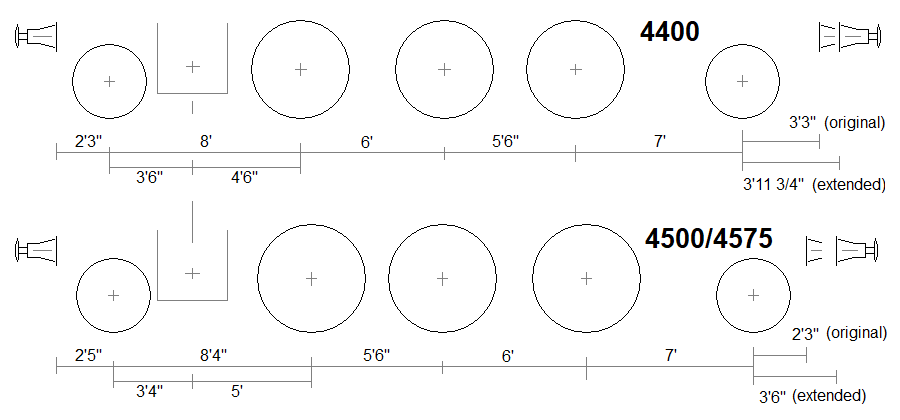
Feature variation and modifications
The small prairies underwent a number of changes throughout their lives, but the range of upgrades were not applied consistently, probably reflecting their lower mileage and hence less frequent works visits. This variation was most marked in the earlier locos and early years – after the 1930s/40s, locos within each class had attained a more uniform appearance.
4400 class
The initial small (2T-3c capacity) bunkers were raised at an early stage to bring the coal capacity to 2T-17c. All received extended frames and bunkers (now up to 3T-14c capacity) except for 4410. 4405's frames remained unextended as late as 1936, and when they were extended, they appeared in '4575' style, with the normal block on the outside face not present.
Extended smokeboxes also appeared at an early stage, but 4407 kept its short one until at least 1925. Topfeed and superheated boilers were fitted from c 1913, although the superheating programme would not be completed (with 4410) until 1927.
4400, 4407 and 4410 gained curved footplate drops (usually when cylinders were replaced) in later years, the remainder kept the square-drop style. 4400, 4406, 4407, 4408 and 4410 received outside-piped cylinder sets, but the others never did.
Chimney styles went in and out of fashion. The class started with a slim cast-iron tapered one. The thin parallel one started to appear from c 1911–12, followed by the fat parallel for a short time in the mid-1920s, before the general adoption of the later cast-iron tapered style, which became the later norm.
ATC was fitted to 4401/6/9 in 1937 and fitted to 4403 in 1943. 4400, 4402, 4404, 4406 and 4409 gained a rear lamp shield, but it is not clear whether any of the rest of the class did. Most members of the class were fitted with cab shutters at a late stage. All members of the class retained the early sandbox style. Some locos (4403, 4404 and 4408) were fitted with heavier balance weights on the centre axle in later years. All survived into the BR era, some receiving BR black livery. Withdrawals took place between 1949 and 1955, with 4405 and 4406 lasting nearly 50 years.
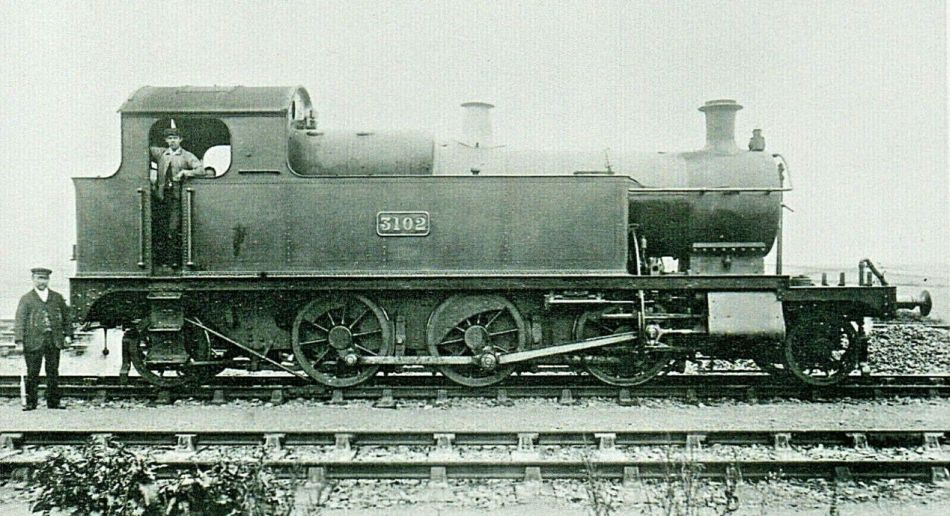
3102, as first built, with a short smokebox, very small bunker (2T-3c capacity) and wooden cab roof. It has a backfeed boiler and is not superheated. The chimney is an early slim cast-iron tapered type. The 4'1½" driving wheels have a very small boss and only 10 spokes. The injectors are out of sight, and the rear sandboxes are under the cab area. Front steps are not yet fitted. No insignia, but full lining is applied.
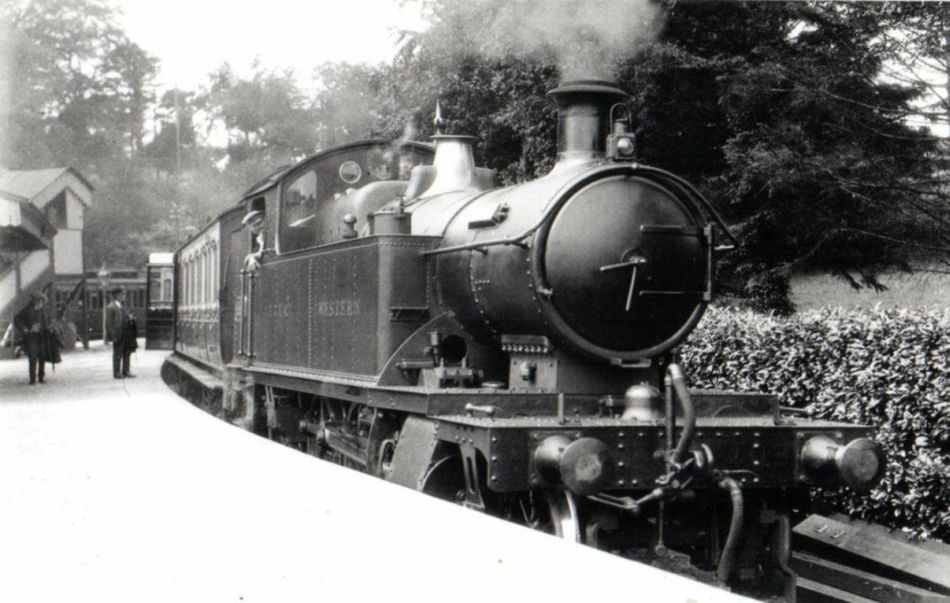
4403 at Yelverton, with a Princetown train. Difficult to date, but probably early- to mid-1920s. The loco still has its old-style lubricator pipe cover, and struts between the smokebox and the front platform are yet to be fitted. The valve covers can just be seen on the vertical part of the platform dropdown section. Porthole windows are in the cab front – in common with other classes, these would be plated over in the late 1920s and early 1930s. Thin parallel chimney. The front steps are angled in to be just slightly less than the 8'9" over-cylinder width.

A mixture of old and new in this works grey portrait of 4409, which I think may be c 1920. The extended smokebox, top feed, steel cab roof and the final type of extended bunker are upgrades on the original design, but front struts have yet to be fitted, and the pony truck cover is of the old style. The shaped plate behind the front area of the slidebars is designed to prevent oil from the slidebar area getting on to the brake shoes, and was a standard feature of all GWR 2-cylinder locos having brake shoes in front of the driving wheels. The front steps are a shorter type. Parallel chimney. The power group C mark is on the cab side with an uncoloured background.
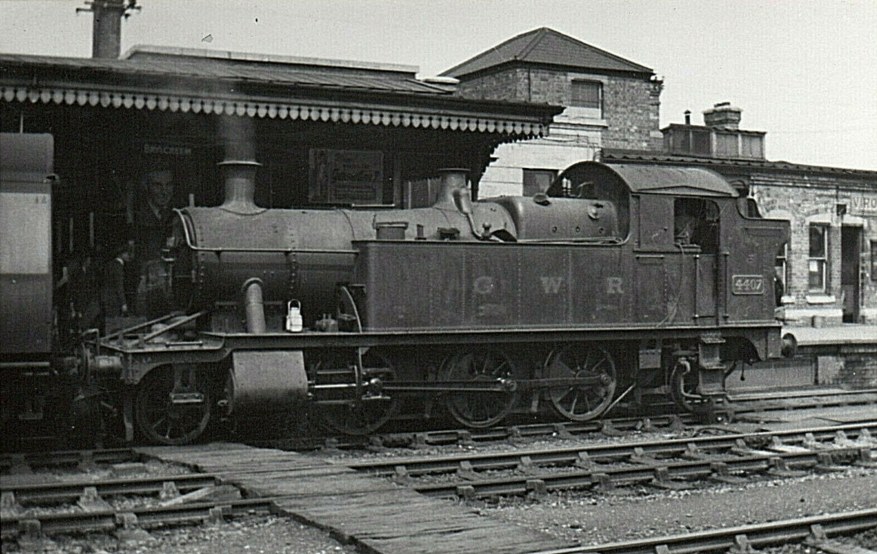
4407 at Swindon, probably early 1950s, with outside steam pipes, a later standard cast-iron tapered chimney, cab shutter, a rear lamp shield on the bunker, and Collett parallel-body buffers. The footplate has been modified at some unknown date to the curved dropdown style, probably coinciding with a cylinder set replacement. As with the large prairies, a handrail has been fitted on top of the boiler.

A short safety valve cover was unusual for locos of the class. 4405 in its last days, at Swindon, 4 September 1955.
4500 class
4500–4519 (originally numbered 2161–2180) were the last GWR locos to be built at Wolverhampton. 4520–4529 (originally numbered 2181–2190) were built at Swindon, as were the remainder of the 4500 and 4575 classes. The initial appearance of the first locos was similar to that of the 4400 class, with short bunkers and short smokeboxes. 4500–29 had square-drop footplates at the front, but some of these (e.g. 4505, 4519 and 4526) received curved dropdown sections in later years. Smokebox struts began to be fitted from 1909. Superheating was incorporated in 1914–1915 with locos 4540–4554.
All of the locos built with short-bunkers (4500–54) were eventually fitted with enlarged bunkers on extended frames, but examples of short bunkers could still be seen in the mid-1920s. Some of the frame lengthening did not feature the usual 'distance blocks', e.g. 4522.
The final lot (of 1924), locos 4555–74, appeared with outside-steam pipes, lengthened frames and enlarged (3T-14c capacity) bunkers.
Chimneys varied, from the early slim tapered cast iron type (as fitted to the 4400 locos) to thin parallel in the post-WWI years to the cast-iron tapered style, which quickly established itself as the default from c 1925. 4568 however, picked up a parallel chimney as late as the mid-1950s. The front steps on most locos of the class were joggled, rather than being bent back as on the 4400s. Most locos had acquired Collett parallel buffers by the mid-1930s. Cab shutters started to be fitted in the early-1930s, and all locos received them. 4500–99 were built with the old style of rear sandbox, and most got retrofitted with the modern style (with the more accessible filler lid), except for 4549, 4562, 4564 and 4571, which never received the upgrade.
| 2161 in original condition with a short smokebox and short, low bunker. The roof is wooden with a transverse shutter. Small-boss drivers. Like the initial state of the 4400 locos, the rear sandbox is behind the cab steps. Full lining is present. |
 |
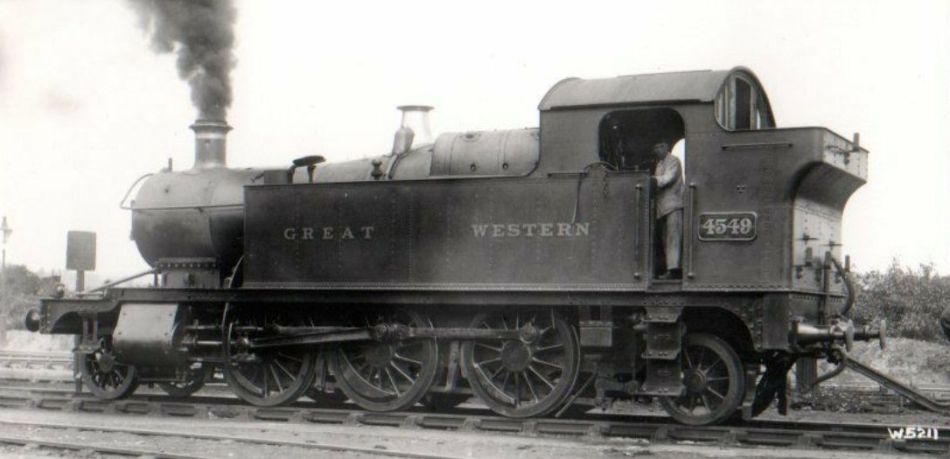
4549, early- to mid-1920s, with a thin parallel chimney, flush-riveted smokebox, no cab shutter and initial type of rear sandbox. The roof is now steel with a normal longitudinal shutter. Dean/Churchward buffers.
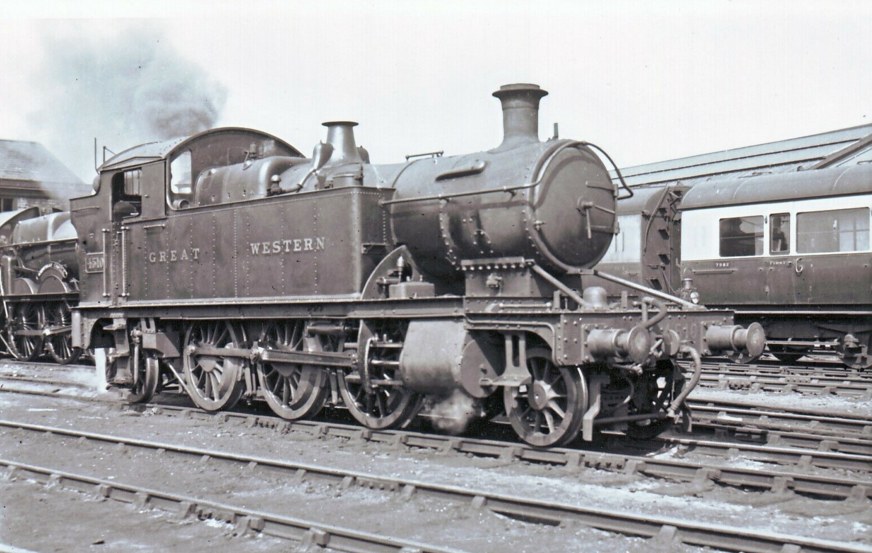
4510, probably mid- to late 1930s. It's smokebox wrapper has a patch indicating the boiler was previously used on an outside-piped loco. Cab shutter and Collett parallel buffers. The tall safety valve cover is painted over.
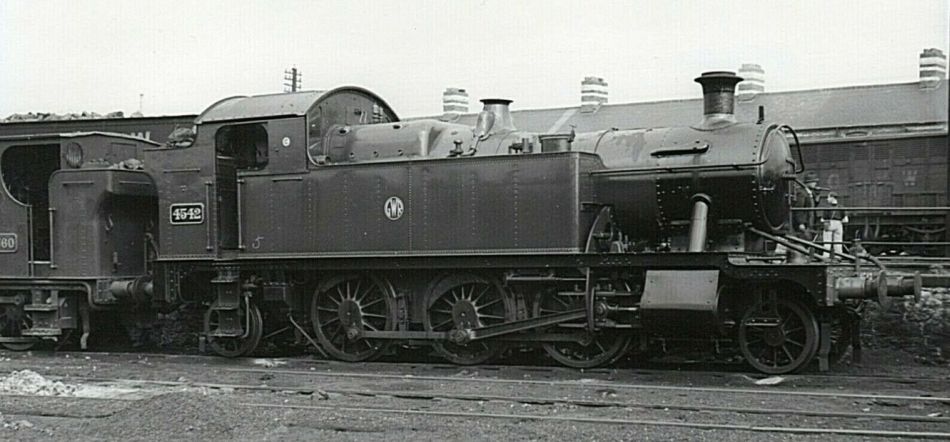
Newly outshopped at Newton Abbot on 10 August 1937, outside-piped 4542 has got a short safety valve bonnet but retains the original style of sandbox. Collett parallel buffers. It does not yet have the handrail on top of the boiler nor the handgrabs on the boiler strap.
| Possibly on route to its home shed of Penzance after a works visit, 4525 is at Bristol Bath Road on 28 August 1948. It should have appeared with Gill Sans 'BRITISH RAILWAYS' insignia, but has been let loose on the road without them. (Long Rock shed might apply the insignia when it arrives there.) The loco retains its square dropdown section at the front of the footplate, and still has small-boss drivers. |
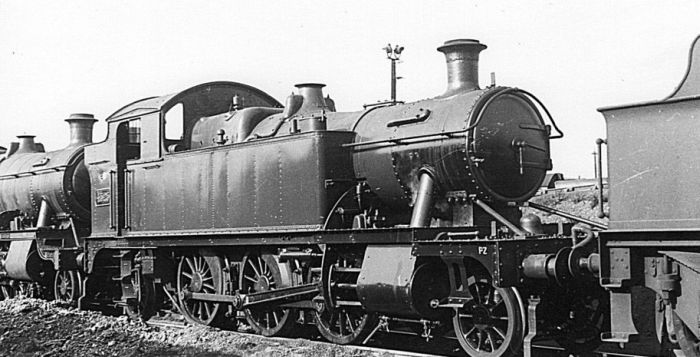 |
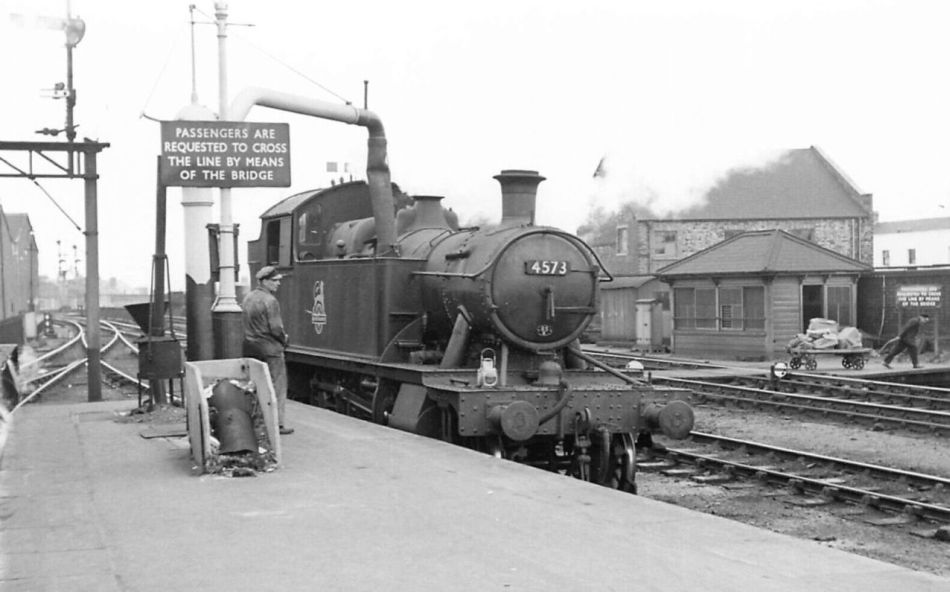
4573 taking water at the western end of Gloucester Central, 1950s.
| The GWR had many types of 4'7" wheel centres. Early 4500 class locos, particularly the Wolverhampton ones, could feature small boss drivers, like the ones shown adjacent on 4509. Small boss drivers could still be seen into the 1950s. |
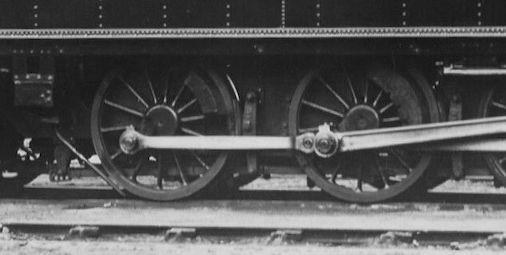 |
4575 class
The only significant developments introduced when Collett continued with the design were the larger (1300g) tanks and flanged motion plates. All 100 of the 4575 locos were built with outside steam pipes. 4575–99 appeared with porthole cabfronts, but later locos dispensed with this feature. 4575–5544 appeared with the initial rear sandbox style, but received the later style in subsequent works visits. Short safety valve covers began to predominate from the early 1930s.
4578, 4581, 4589, 5511, 5524, 5529, 5534, 5545, 5555 and 5549 were autofitted from 1953.
The last four locomotives of the class were withdrawn in December 1964. |

All the small prairies were built with the 'twin-strips' style of brake hangers, but many of them were upgraded to this later cast style, as shown here on preserved 5542. It is thought this later style appeared toward the end of the GWR era.
The picture also shows how the balance weights protrude from the wheel faces. |
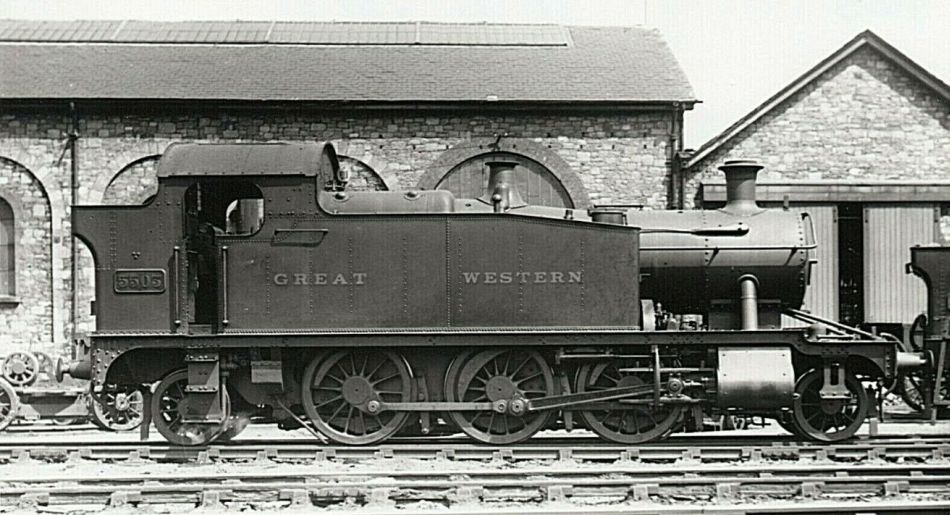
5503 at Newton Abbot, with Collett taper buffers, a tall safety valve cover and original style rear sandbox. Cab shutter not yet fitted. Probably late-1920s.
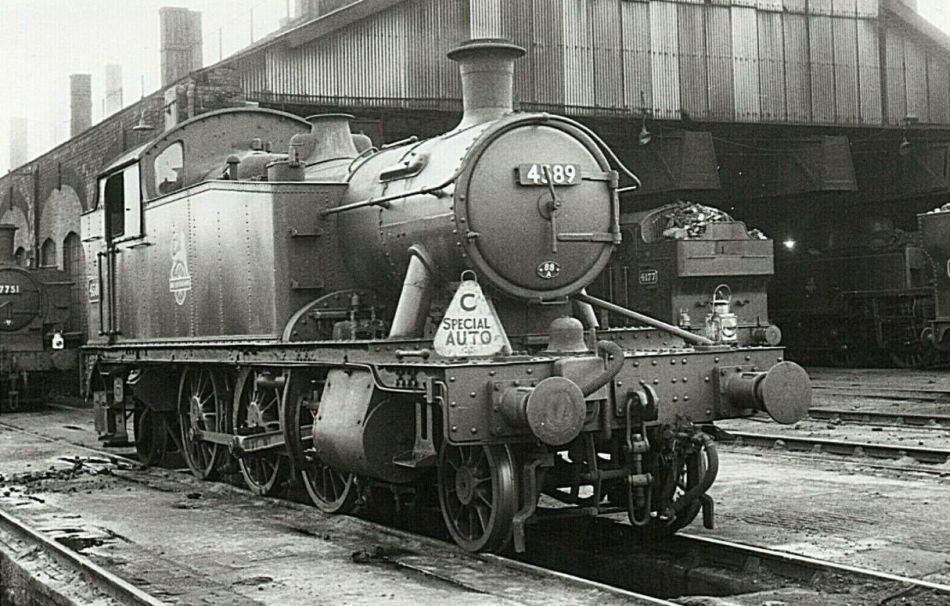
Auto-fitted 4589 at Cardiff Cathays in 1957.

4592 at Laira on 29 May 1958. Many small prairies were in lined green at that period.
|

















